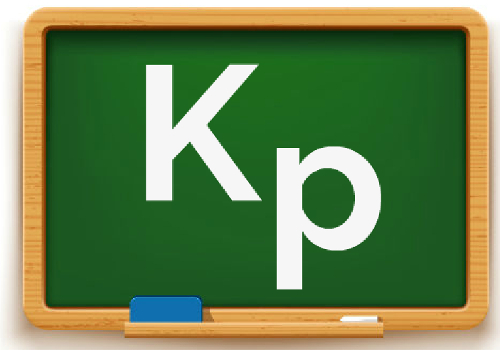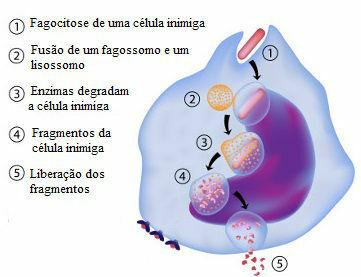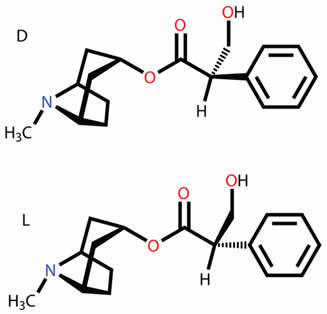Concentration in amount of matterit is a way of quantifying the solute and its ions in a solution. This form of concentration lists the number of moles of solute and the volume of the entire solution:
M = no1
V
M = concentration in quantity of matter
no1 = number of moles of the solute
V = solution volume
However, the amount of solute matter can be calculated specifically using the division of the mass of the solute (m1) by its molar mass (M1). This relationship can be seen in the formula below:
no1 = m1
M1
In this way, knowing the formula for the concentration in amount of matter and the formula for the amount of matter, we can relate the two by replacing the n.1 by the relation m1/M1 this way:
M = m1
M1.V
This formula will be used whenever the exercise provides the mass of the solute (m1), and not the amount of matter present in the solution.
Regarding the unit of measure, we must use mo/L for the concentration in quantity of matter, given that the unit used for the number of mol of the solute is the mol and the unit used for the volume of the solution is the liter (L). It is also possible to use molar or M units in place of mol/L.
follow up two examples of formulas on the concentration in quantity of matter:
Example 1: Calculate the concentration in matter quantity of a solution that has 0.6 mol of Na2ONLY4 in 400 mL of solution.
Exercise data:
M = ?
no1 = 0.6 mol
V = 400 ml. The volume, however, must be worked in Liter. To do this, just divide the value provided by 100. Thus, V = 0.4 L.
We now use the values provided in the expression of concentration in quantity of matter:
M = no1
V
M = 0,6
0,4
M = 1.5 mol/L
Example 2: What is the mass of sodium sulfate (Na2ONLY4) which must be dissolved in water to complete the volume of 500 mL solution, so that a solution of 0.03 mol/L is obtained?
Exercise data:
m1 = ?
V = 500 ml. Dividing by 1000, we get 0.5 L;
M = 0.03 mol/L
To determine the molar mass of the solute in the exercise, simply multiply the mass value of each element by the number of atoms in the solute formula, Na2ONLY4, and add the results:
Do not stop now... There's more after the advertising ;)
For Na, we have:
2.23 = 46 g/mol
For the S, we have:
1.32 = 32 g/mol
For O, we have:
4.16 = 64 g/mol
Now we add the results found for each element:
M1 = 46 + 32 + 64
M1 = 142 g/mol
With these data, we can determine the value of the mass of the solute (m1) through the formula of concentration in quantity of matter:
M = m1
M1.V
0,03 = m1
142.0,5
0,03 = m1
71
m1 = 0,03.71
m1 = 2.13 g
Concentration in amount of ion matter
To determine the concentration in amount of matter of the ions referring to the solute in the solution, it is enough to know the concentration in quantity of matter of the solute in the solution. See some examples:
Example 1: Determine the concentration in amount of matter of Magnesium ions (Mg+2) and Chlorine (Cl-) present in a solution that was prepared by dissolving 50 grams of MgCl2 in water, which resulted in 800 mL of solution. Data: (Molar masses: Mg = 24g/mol, Cl = 35 g/mol)
Exercise data:
m1 = 50 grams
V = 800 ml. Dividing by 1000, we get 0.8 L.
To determine the molar mass of the solute in the exercise, simply multiply the mass value of each element by the number of atoms in the solute formula., MgCl2, and add the results:
For Mg, we have:
Mg = 1.24 = 24g/mol
For Cl, we have:
Cl2 = 2.35.5 = 71g/mol
Adding the results found for each element, we have:
M1 = 24 +71
M1 = 95 g/mol
Before determining the concentration in quantity of matter of each ion, we must first find the concentration in quantity of matter in the solution.
M = m1
M1.V
M = 50
95.0,8
M = 50
76
M = 0.65 mol/L
Now, knowing the concentration of the entire solution, just multiply it by the amount of the ion in the formula to find its concentration:
For the Magnesium cation (Mg+2):
[Mg+2] = 1. 0,65
[Mg+2] = 0.65 mol/L
For Chloride (Cl-)
[Cl-1] = 2. 0,65
[Cl-1] = 1.30 mol/L
By Me. Diogo Lopes Dias
Would you like to reference this text in a school or academic work? Look:
DAYS, Diogo Lopes. "What is concentration in quantity of matter?"; Brazil School. Available in: https://brasilescola.uol.com.br/o-que-e/quimica/o-que-e-concentracao-quantidade-materia.htm. Accessed on June 28, 2021.
What is Chemistry?

Understand what Kp is, the equilibrium constant in terms of pressure, and know how to obtain it by using pressures partials of all gases present in a chemical equilibrium, which can be in atmospheres (atm) or millimeters of mercury (mmHg). Click here and find out more about this subject!
Solution, Solid Solution. Liquid solution, gaseous solution, solutions formed by gas and liquid, solutions formed by liquids.


